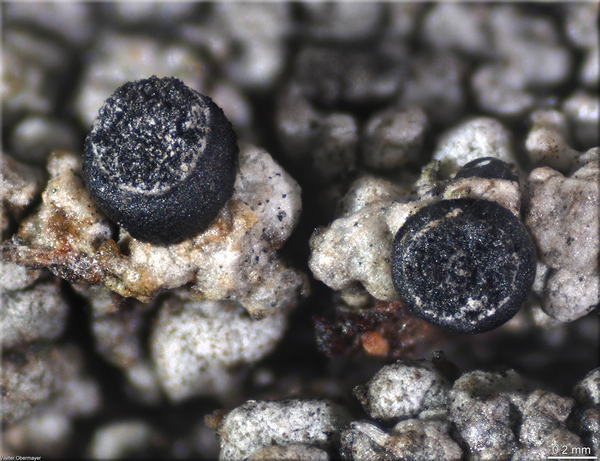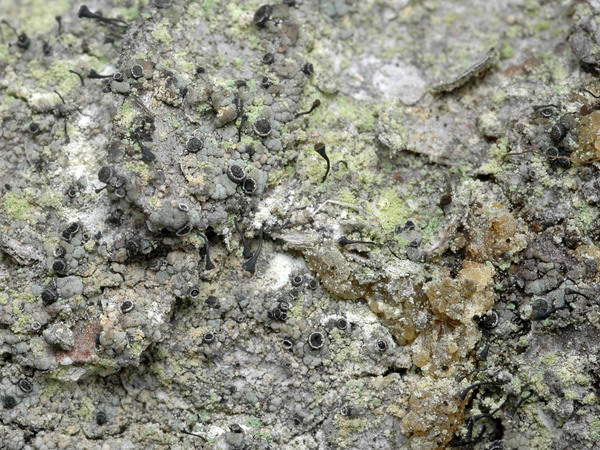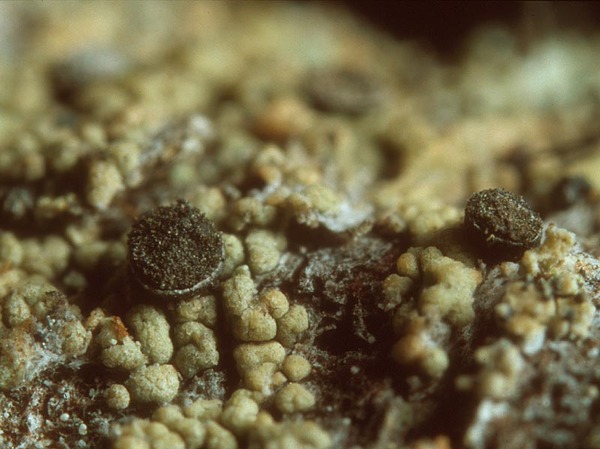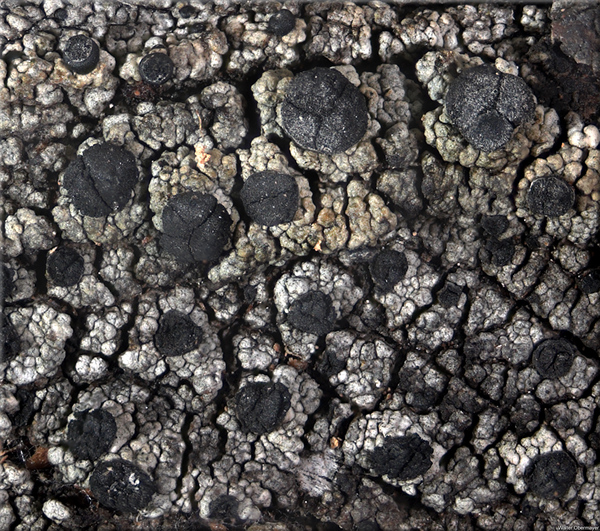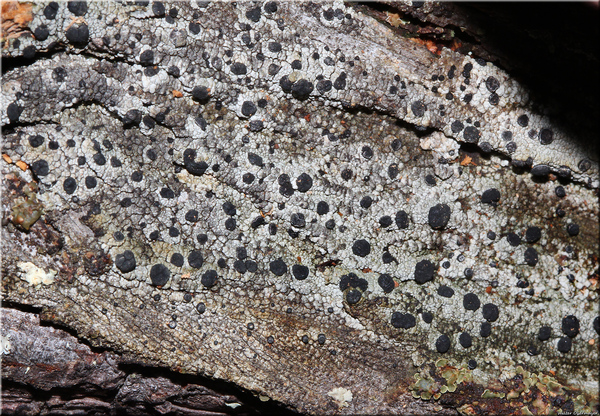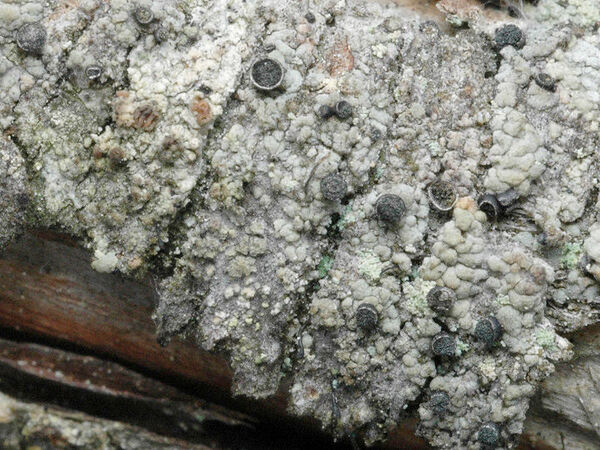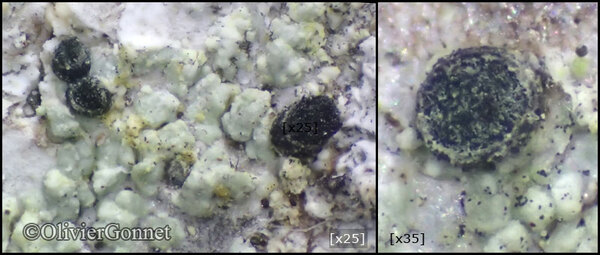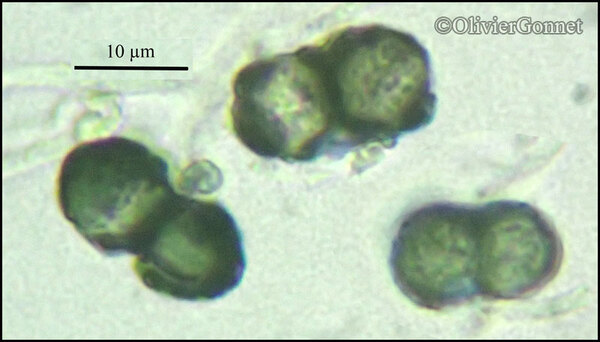Acolium karelicum (Vain.) M. Prieto & Wedin
Fungal Divers., 2016 (MB 817532). Basionym: Cyphelium lucidum var. karelicum Vain. - Acta Soc. Fauna Fl. Fenn., 57, 1: 20, 1927.
Synonyms: Cyphelium karelicum (Vain.) Räsänen
Distribution: N - TAA (Thor & Nascimbene 2007, Nascimbene & al. 2008c, 2009, 2010, 2022, Nimis & al. 2015). S - Bas (Puntillo & Puntillo 2009, Puntillo & al. 2012), Cal (Puntillo 1994, 1996, Puntillo & Puntillo 2009).
Description: Thallus crustose, episubstratic, rather thin, verrucose or subareolate, smooth, greenish grey when fresh, assuming a brownish tinge in the herbarium. Apothecia sessile, short-cylindrical or lenticular, 0.3-0.7 mm across, 0.3-0.4(-0.5) mm high, with a black, flattened mazaedium and a slightly pruinose margin. Proper exciple 40-140 µm thick laterally, expanded at the base up to 380 µm, of dark brown, sclerotized hyphae; hypothecium 110-140 µm thick, of periclinally arranged, sclerotized hyphae. Asci cylindrical, formed singly from hooked ascogenous hyphae, persisting until the spores are nearly ripe, with uniseriately arranged spores, 28-33 x 4-5 µm. Ascospores 1-septate, clearly constricted at septum, dark brown, ellipsoid, 12-17 x 7.5-10 µm, the wall at first smooth, later with cracks delimiting irregular polygonal areas. Photobiont chlorococcoid. Spot tests: thallus K-, C-, KC-, P-. Chemistry: low amounts of placodiolic acid and three unidentified substances.Note: a mainly cool-temperate to southern boreal-montane lichen found on ancient boles of conifers in semi-natural montane forests, often on basal parts of trunks, mostly on old Abies, much more rarely on lignum, from the Alps to the mountains of Southern Italy. It is included in the Italian red list of epiphytic lichens as “Endangered” (Nascimbene & al. 2013c).
Growth form: Crustose
Substrata: bark
Photobiont: green algae other than Trentepohlia
Reproductive strategy: mainly sexual
Most common in areas with a humid-warm climate (e.g. most of Tyrrenian Italy)
Commonnes-rarity: (info)
Alpine belt: absent
Subalpine belt: absent
Oromediterranean belt: absent
Montane belt: very rare
Submediterranean belt: absent
Padanian area: absent
Humid submediterranean belt: absent
Humid mediterranean belt: absent
Dry mediterranean belt: absent

Predictive model
Herbarium samples
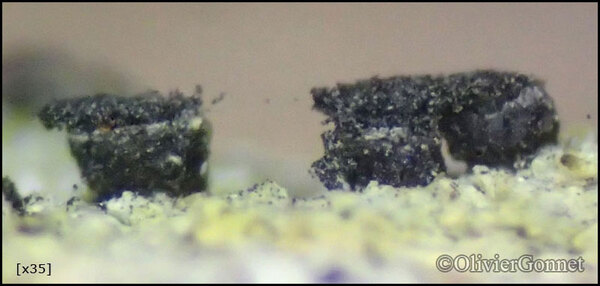
Courtesy Danièle et Olivier Gonnet - Source: https://www.afl-lichenologie.fr/Photos_AFL/Photos_AFL_A/Textes_A3/Acolium_karelicum.htm
France, sur Picea abies - Bellefontaine - Jura
14/5/2017
Growth form: Crustose
Substrata: bark
Photobiont: green algae other than Trentepohlia
Reproductive strategy: mainly sexual
Most common in areas with a humid-warm climate (e.g. most of Tyrrenian Italy)
Commonnes-rarity: (info)
Alpine belt: absent
Subalpine belt: absent
Oromediterranean belt: absent
Montane belt: very rare
Submediterranean belt: absent
Padanian area: absent
Humid submediterranean belt: absent
Humid mediterranean belt: absent
Dry mediterranean belt: absent

Predictive model
| Herbarium samples |

 INDEX FUNGORUM
INDEX FUNGORUM
 GBIF
GBIF
 DOLICHENS
DOLICHENS
